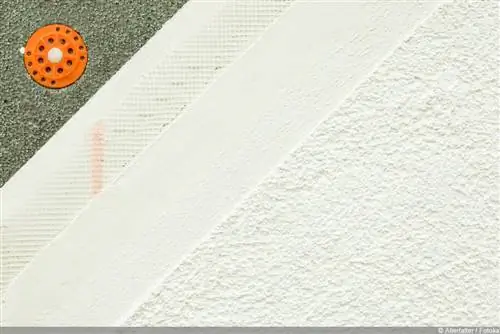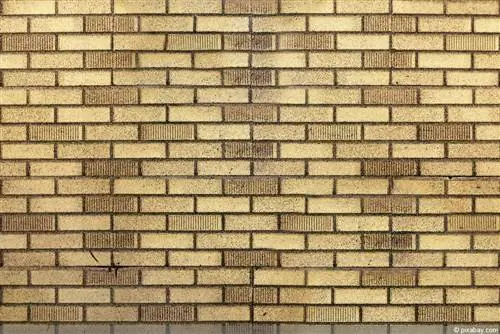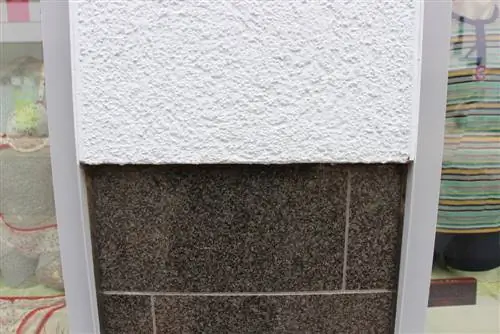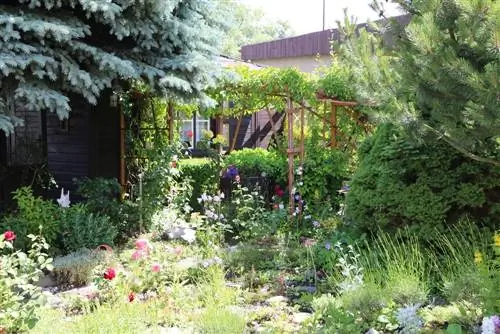- Author admin [email protected].
- Public 2023-12-17 03:39.
- Last modified 2025-01-24 12:45.
Cracks in the exterior facade of a building are, in most cases, completely normal and age-related. After all, the plaster is exposed to the elements every day. Of course it wears out. Such a crack in the plaster must be closed again in order to avoid damage to the building structure. However, if the crack goes deeper, it could be an indication of much larger problems with the building.
Preliminary examination
Before you as a homeowner start repairing cracks in the plaster, you would do well to first determine what type of crack it is. A precise damage analysis should therefore be carried out. Basically, two types of cracks can be distinguished. On the one hand there are the cracks caused by the plaster. In most cases they are superficial and actually only affect the plaster itself.
Repairing is relatively easy here and does not require any special expertise or great craftsmanship. However, the situation is different with so-called dynamic cracks. They go much deeper and usually affect not the plaster alone, but also the masonry underneath. A dynamic crack is usually a clear indication of defects in the building structure - and these defects can be very dangerous.
Note:
A dynamic crack must be examined in more detail by a qualified construction expert. Professionals are then required to repair the causes of the crack.
Detect crack type
It should have become clear by now that it is crucial to identify what type of crack is visible in the external plaster. Luckily, there are a few relatively clear features that can help distinguish them.
Plaster crack:
- only superficial, not deep
- only the plaster affected
- the masonry is not affected
- usually occurs over a large area as a combination of network cracks
- sometimes difficult to see
Dynamic Rift
- clear, relatively wide crack
- often reaching up to the masonry
- Plaster elements break easily
- often found near wall breakthroughs
Tip:
If you are unsure what type of crack it is, you should consult a building expert. Although it costs money, the early detection of a dynamic crack also helps to save costs.
Repair plaster cracks
Mending a plaster crack is no big deal. Depending on the type and size of the crack or cracks, two methods can be used. Method 1 is to cover a large area of the crack. There are special materials for this that are available in every hardware store. This variant is particularly suitable for particularly fine plaster cracks, which can often be found in a network of cracks or a network of cracks. The second method, however, is used for slightly larger, or more precisely: wider, cracks in the external plaster. Such a crack is filled. Here too, the suitable filling material can easily be found in the hardware store. Since both methods do not affect the building structure itself, the work can easily be carried out by laypeople.
Cover crack
Covering a single crack or a network of cracks basically means nothing more than applying a new layer of plaster on top of the old one. This can be done partially or across the board, i.e. affecting the entire wall. To do this, you can either get so-called rolled plaster with a grain size of 0.5 mm or a mineral plaster with a grain size of 2 mm from the hardware store. While the mineral plaster must first be mixed with water according to the manufacturer's instructions, the rolled plaster can be used immediately.

Mineral plaster is applied over a large area with a so-called plastering trowel and then carefully spread evenly. The rolling plaster is applied using a standard paint roller. It is important to achieve a certain minimum strength. 15 mm is recommended. After drying for several days, the newly plastered area finally has to be painted.
Tip:
Even if it takes a lot more work, completely plastering a wall makes sense. Then you're not only on the safe side, but it's also easier with the right coat of paint.
Filling cracks
If you want or need to fill a crack, you need suitable filling material. This is available as a dry substance and must be mixed with water according to the manufacturer's instructions. This creates a mortar-like mass, which is then poured directly into the crack with a spatula until it is completely filled. After it has dried, the area in question is then generously plastered again with the mixture. The plaster must be applied beyond the actual width of the crack.
Basic Tips
No matter whether you want to cover or fill cracks, it is advisable to clean the surface thoroughly beforehand. This is best done with a damp, relatively soft brush. It is also important to only carry out the work when the weather is nice and dry. It must also be ensured that it is no longer freezing outside. Since the cracks are often in places that are difficult to reach, a ladder or scaffolding is usually required. For safety reasons, scaffolding is always preferred. It also allows more freedom of movement. Small scaffolding can be rented from virtually any hardware store for a fee.






